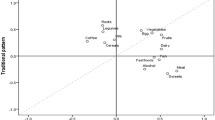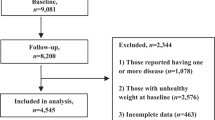Abstract
Background/Objectives:
Dietary patterns represent the combined effects of foods and efficaciously illustrate the impact of diet on health outcomes. This study identified the dietary patterns and determined their relationships with obesity among young Chinese women.
Subjects/Methods:
In 2011, the China Health and Nutrition Survey included 2363 young women aged 18–44 years. Factor analysis of data from three consecutive 24-h dietary recalls identified the dietary patterns. Weight, height and waist circumstance (WC) were measured, and body mass index (BMI) was calculated. General obesity was defined as BMI ⩾28 kg/m2 and abdominal obesity as WC ⩾85 cm.
Results:
Four dietary patterns were identified: traditional south; traditional north; snack; and high protein. After adjusting for confounders and energy intake, women in the highest-score quintiles of the traditional south pattern were less likely to have general obesity (odds ratio (OR)=0.48; 95% confidence interval (CI) 0.29–0.78) and abdominal obesity (OR=0.64; 95% CI 0.46–0.90). Subjects in the highest-score quintiles of the traditional north pattern had significantly greater risk of general obesity (OR=2.28; 95% CI 1.38–3.74) and of abdominal obesity (OR=2.32; 95% CI 1.66–3.24).
Conclusion:
The traditional south pattern of rice as the major staple food with pork and vegetable dishes is associated with lower risk of general and abdominal obesity. The traditional north pattern of high intake of wheat, other cereals and tubers is positively associated with general and abdominal obesity. This provides important information for interventions and policies addressing obesity prevention among young Chinese women.
This is a preview of subscription content, access via your institution
Access options
Subscribe to this journal
Receive 12 print issues and online access
$259.00 per year
only $21.58 per issue
Buy this article
- Purchase on Springer Link
- Instant access to full article PDF
Prices may be subject to local taxes which are calculated during checkout
Similar content being viewed by others
References
Rokholm B, Baker JL, Sorensen TI . The levelling off of the obesity epidemic since the year 1999—a review of evidence and perspectives. Obes Rev 2010; 11: 835–846.
Popkin BM, Adair LS, Ng SW . Global nutrition transition and the pandemic of obesity in developing countries. Nutr Rev 2012; 70: 3–21.
Stevens GA, Singh GM, Lu Y, Danaei G, Lin JK, Finucane MM et al. National, regional, and global trends in adult overweight and obesity prevalences. Popul Health Metr 2012; 10: 22.
Xi B, Liang Y, He T, Reilly KH, Hu Y, Wang Q et al. Secular trends in the prevalence of general and abdominal obesity among Chinese adults, 1993-2009. Obes Rev 2012; 13: 287–296.
Nguyen DM, El-Serag HB . The epidemiology of obesity. Gastroenterol Clin North Am 2010; 39: 1–7.
Bray GA, Paeratakul S, Popkin BM . Dietary fat and obesity: a review of animal, clinical and epidemiological studies. Physiol Behav 2004; 83: 549–555.
Boeing H, Bechthold A, Bub A, Ellinger S, Haller D, Kroke A et al. Critical review: vegetables and fruit in the prevention of chronic diseases. Eur J Nutr 2012; 51: 637–663.
Anderson JW, Baird P, Davis Jr RH, Ferreri S, Knudtson M, Koraym A et al. Health benefits of dietary fiber. Nutr Rev 2009; 67: 188–205.
Hu FB . Dietary pattern analysis: a new direction in nutritional epidemiology. Curr Opin Lipidol 2002; 13: 3–9.
Van Horn L . Eating pattern analyses: the whole is more than the sum of its parts. J Am Diet Assoc 2011; 111: 203.
Tucker KL . Dietary patterns, approaches, and multicultural perspective. Appl Physiol Nutr Metab 2010; 35: 211–218.
Kant AK . Dietary patterns and health outcomes. J Am Diet Assoc 2004; 104: 615–635.
Popkin BM . Synthesis and implications: China's nutrition transition in the context of changes across other low- and middle-income countries. Obes Rev 2014; 15 (Suppl 1), 60–67.
Zhai FY, Du SF, Wang ZH, Zhang JG, Du WW, Popkin BM . Dynamics of the Chinese diet and the role of urbanicity, 1991-2011. Obes Rev 2014; 15 (Suppl 1), 16–26.
Rezazadeh A, Rashidkhani B . The association of general and central obesity with major dietary patterns in adult women living in Tehran, Iran. ARYA Atheroscler 2010; 6: 23–30.
Okubo H, Sasaki S, Murakami K, Kim MK, Takahashi Y, Hosoi Y et al. Three major dietary patterns are all independently related to the risk of obesity among 3760 Japanese women aged 18-20 years. Int J Obes (Lond) 2008; 32: 541–549.
Kim JH, Lee JE, Jung IK . Dietary pattern classifications and the association with general obesity and abdominal obesity in Korean women. J Acad Nutr Diet 2012; 112: 1550–1559.
Quatromoni PA, Copenhafer DL, D'Agostino RB, Millen BE . Dietary patterns predict the development of overweight in women: The Framingham Nutrition Studies. J Am Diet Assoc 2002; 102: 1239–1246.
Schulze MB, Fung TT, Manson JE, Willett WC, Hu FB . Dietary patterns and changes in body weight in women. Obesity (Silver Spring) 2006; 14: 1444–1453.
Boggs DA, Palmer JR, Spiegelman D, Stampfer MJ, Adams-Campbell LL, Rosenberg L . Dietary patterns and 14-y weight gain in African American women. Am J Clin Nutr 2011; 94: 86–94.
Popkin BM, Du S, Zhai F, Zhang B . Cohort Profile: The China Health and Nutrition Survey—monitoring and understanding socio-economic and health change in China, 1989-2011. Int J Epidemiol 2009; 39: 1435–1440.
Zhang B, Zhai FY, Du SF, Popkin BM . The China Health and Nutrition Survey, 1989-2011. Obes Rev 2014; 15 (Suppl 1), 2–7.
Popkin BM . Reducing meat consumption has multiple benefits for the world's health. Arch Intern Med 2009; 169: 543–545.
WHO Expert Committee. Physical status: the use and interpretation of anthropometry. Tech Rep Ser 1995; 854: 1–452.
Zhou BF . Cooperative Meta-Analysis Group of the Working Group on Obesity in China. Predictive values of body mass index and waist circumference for risk factors of certain related diseases in Chinese adults—study on optimal cut-off points of body mass index and waist circumference in Chinese adults. Biomed Environ Sci 2002; 15: 83–96.
Yang Y, Wang G, Pan X . Chinese Food Composition Tables 2002. Peking University Medical Press: Beijing, China, 2002.
Du SF, Wang HJ, Zhang B, Zhai FY, Popkin BM . China in the period of transition from scarcity and extensive undernutrition to emerging nutrition-related non-communicable diseases, 1949-1992. Obes Rev 2014; 15 (Suppl 1), 8–15.
Wang D, He Y, Li Y, Luan D, Yang X, Zhai F et al. Dietary patterns and hypertension among Chinese adults: a nationally representative cross-sectional study. BMC Public Health 2011; 11: 925.
Batis C, Sotres-Alvarez D, Gordon-Larsen P, Mendez MA, Adair L, Popkin B . Longitudinal analysis of dietary patterns in Chinese adults from 1991–2009. Br J Nutr 2014; 111: 1441–1451.
Gao X, Yao M, McCrory MA, Ma G, Li Y, Roberts SB et al. Dietary pattern is associated with homocysteine and B vitamin status in an urban Chinese population. J Nutr 2003; 133: 3636–3642.
Tucker KL, Chen H, Hannan MT, Cupples LA, Wilson PW, Felson D et al. Bone mineral density and dietary patterns in older adults: the Framingham Osteoporosis Study. Am J Clin Nutr 2002; 76: 245–252.
Wang Z, Zhai F, Zhang B, Popkin BM . Trends in Chinese snacking behaviors and patterns and the social-demographic role between 1991 and 2009. Asia Pac J Clin Nutr 2012; 21: 253–262.
Shi Z, Yuan B, Hu G, Dai Y, Zuo H, Holmboe-Ottesen G . Dietary pattern and weight change in a 5-year follow-up among Chinese adults: results from the Jiangsu Nutrition Study. Br J Nutr 2011; 105: 1047–1054.
Sichieri R . Dietary patterns and their associations with obesity in the Brazilian city of Rio de Janeiro. Obes Res 2002; 10: 42–48.
Foster-Powell K, Holt SH, Brand-Miller JC . International table of glycemic index and glycemic load values: 2002. Am J Clin Nutr 2002; 76: 5–56.
Chiu YT, Stewart ML . Effect of variety and cooking method on resistant starch content of white rice and subsequent postprandial glucose response and appetite in humans. Asia Pac J Clin Nutr 2013; 22: 372–379.
Park SH, Lee KS, Park HY . Dietary carbohydrate intake is associated with cardiovascular disease risk in Korean: analysis of the third Korea National Health and Nutrition Examination Survey (KNHANES III). Int J Cardiol 2010; 139: 234–240.
Lin H, Bermudez OI, Tucker KL . Dietary patterns of Hispanic elders are associated with acculturation and obesity. J Nutr 2003; 133: 3651–3657.
Kim J, Jo I, Joung H . A rice-based traditional dietary pattern is associated with obesity in Korean adults. J Acad Nutr Diet 2012; 112: 246–253.
Mittendorfer B, Sidossis LS . Mechanism for the increase in plasma triacylglycerol concentrations after consumption of short-term, high-carbohydrate diets. Am J Clin Nutr 2001; 73: 892–899.
Garcia OP, Ronquillo D, Caamano Mdel C, Camacho M, Long KZ, Rosado JL . Zinc, vitamin A, and vitamin C status are associated with leptin concentrations and obesity in Mexican women: results from a cross-sectional study. Nutr Metab (Lond) 2012; 9: 59.
Isganaitis E, Lustig RH . Fast food, central nervous system insulin resistance, and obesity. Arterioscler Thromb Vasc Biol 2005; 25: 2451–2462.
Garcia OP, Long KZ, Rosado JL . Impact of micronutrient deficiencies on obesity. Nutr Rev 2009; 67: 559–572.
Martinez ME, Marshall JR, Sechrest L . Invited commentary: factor analysis and the search for objectivity. Am J Epidemiol 1998; 148: 17–19.
Acknowledgements
This research uses data from the CHNS. We thank the National Institute for Nutrition and Health, Chinese Center for Disease Control and Prevention; the Carolina Population Center (5 R24 HD050924), University of North Carolina at Chapel Hill, the National Institutes of Health (NIH) (R01-HD30880, DK056350, R24 HD050924, and R01-HD38700); and the Fogarty International Center, NIH, for financial support for the CHNS data collection and analysis of files from 1989 to 2011, and for future surveys.
Author information
Authors and Affiliations
Corresponding author
Ethics declarations
Competing interests
The authors declare no conflict of interest.
Rights and permissions
About this article
Cite this article
Zhang, J., Wang, Z., Wang, H. et al. Dietary patterns and their associations with general obesity and abdominal obesity among young Chinese women. Eur J Clin Nutr 69, 1009–1014 (2015). https://doi.org/10.1038/ejcn.2015.8
Received:
Revised:
Accepted:
Published:
Issue Date:
DOI: https://doi.org/10.1038/ejcn.2015.8
This article is cited by
-
Association of dietary patterns with general and central obesity among Chinese adults: a longitudinal population-based study
BMC Public Health (2023)
-
Comparison of different obesity indices associated with type 2 diabetes mellitus among different sex and age groups in Nantong, China: a cross-section study
BMC Geriatrics (2022)
-
Exposure-lag-response associations between extreme environmental conditions and primary Sjögren’s syndrome
Clinical Rheumatology (2022)
-
Individualized body bioelectrical impedance parameters in newly diagnosed cancer children
Translational Medicine Communications (2020)



